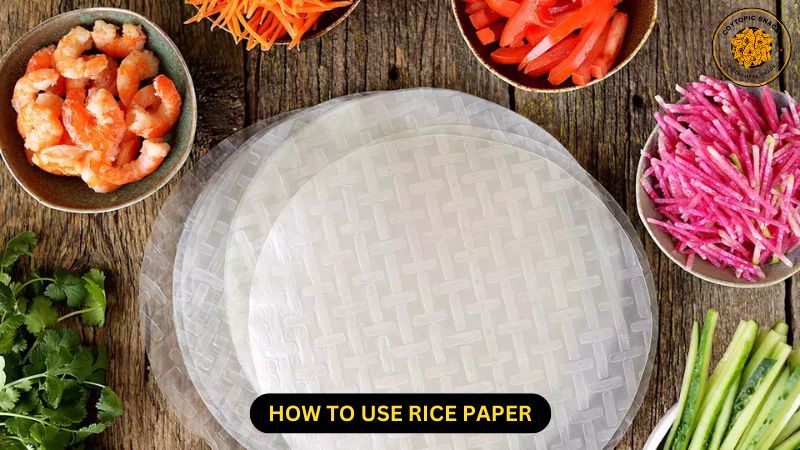Blog
How to Use Rice Paper: A Comprehensive Guide
Rice paper is a versatile and delicate ingredient used in many global cuisines, especially in Southeast Asian cooking. Its thin, translucent texture makes it ideal for wrapping, frying, or even creating unique decorative touches. Whether you’re a home cook experimenting with new recipes or a professional chef looking for creative ways to elevate your dishes, understanding how to use rice paper can expand your culinary repertoire.
This article will guide you through everything you need to know about how to use rice paper, including what it is, where to buy it, and its many applications in cooking and beyond.
What is Rice Paper?
Rice paper is a thin, edible sheet made primarily from rice flour, tapioca starch, water, and salt. It originated in Vietnam and is widely used in Vietnamese, Thai, and Chinese cuisine. Its unique combination of pliability and strength makes it suitable for wrapping various fillings.
Types of Rice Paper:
- Spring Roll Wrappers: Most commonly used for fresh or fried spring rolls.
- Rice Paper Sheets: Used in crafts or dessert-making, often thinner than spring roll wrappers.
- Decorative Rice Paper: Edible but designed for decorative purposes, like cake decorations.
How to Choose and Store Rice Paper
Where to Buy Rice Paper
Rice paper is available in most Asian grocery stores, online marketplaces, and even the international sections of supermarkets. Look for brands like Three Ladies or Banh Trang for quality products.
Storage Tips
- Unopened Packs: Store in a cool, dry place.
- Opened Packs: Transfer to an airtight container or resealable bag to prevent moisture exposure.
Rice paper has a long shelf life if stored properly but can become brittle if exposed to air or humidity.
How to Prepare Rice Paper
Before using rice paper, it needs to be softened. Here’s how to do it:
Soaking Method
- Fill a shallow bowl or plate with warm water.
- Dip the rice paper into the water for 5–10 seconds.
- Remove and place it on a clean, damp surface like a kitchen towel or plate.
Tips for Success
- Avoid oversoaking, as the paper can become too sticky or tear.
- Use warm water instead of hot to maintain texture.
- Work with one sheet at a time to prevent sticking.
How to Use Rice Paper
Rice paper is incredibly versatile. Below are its most popular uses:
Fresh Spring Rolls
Fresh spring rolls, or gỏi cuốn, are a staple in Vietnamese cuisine. They are healthy, light, and easy to prepare.
Ingredients:
- Rice paper
- Protein: Shrimp, chicken, tofu, or pork
- Vegetables: Lettuce, carrots, cucumber, and herbs like mint or cilantro
- Vermicelli noodles
Steps:
- Soak rice paper as described above.
- Place fillings in the center.
- Fold the sides in, then roll tightly like a burrito.
- Serve with hoisin-peanut sauce or nuoc cham (Vietnamese dipping sauce).
Fried Spring Rolls
Fried spring rolls, or chả giò, use rice paper as a wrapper for a crunchy, golden result.
Tips for Frying:
- Use dry fillings to avoid sogginess.
- Roll tightly to prevent oil seeping in.
- Fry at medium heat to ensure even cooking without burning.
Rice Paper Dumplings
Rice paper can substitute for traditional dumpling wrappers for a gluten-free alternative.
Steps:
- Soften the rice paper and place the filling in the center.
- Fold into a pouch shape.
- Steam or fry until cooked.
Snacks and Chips
Unused rice paper can transform into crispy snacks:
- Cut rice paper into desired shapes.
- Brush lightly with oil and sprinkle with salt or spices.
- Bake or fry until crisp.
Dessert Wraps
Rice paper pairs well with sweet fillings like coconut, banana, or Nutella. Wrap and fry for a delightful treat.
Non-Culinary Uses of Rice Paper
While primarily a food ingredient, rice paper also has applications beyond the kitchen:
Art and Crafts
- Calligraphy: Its thin texture makes it perfect for delicate lettering.
- Decoupage: Used as a medium for decorating furniture or crafts.
Food Presentation
- Edible Decorations: Rice paper can be shaped or painted with edible ink for cakes and pastries.
- Plating: Adds an elegant touch when used as a base for appetizers or desserts.
Common Mistakes and How to Avoid Them
Over-Soaking
Rice paper only needs a brief soak. Over-soaking leads to tearing or stickiness.
Using Wet Fillings
Excess moisture in fillings can break the wrapper. Ensure ingredients are dry.
Improper Storage
Store rice paper in a sealed container to prevent drying out or brittleness.
Health Benefits of Rice Paper
Rice paper is a healthy alternative to traditional bread or pastry-based wrappers.
Low-Calorie
Rice paper is light and low in calories, making it ideal for healthy wraps.
Gluten-Free
Naturally gluten-free, it’s a great option for those with dietary restrictions.
Minimal Ingredients
Free from preservatives or additives, rice paper is a clean ingredient.
Frequently Asked Questions
Q1: Can rice paper be eaten raw?
Yes, rice paper is safe to eat without cooking. Use it for fresh spring rolls or wraps.
Q2: Can I microwave rice paper?
Microwaving is not recommended for softening but can be used to make rice paper chips.
Q3: What can I substitute for rice paper?
Lettuce leaves or tortilla wraps can work as substitutes, depending on the recipe.
Creative Ideas for Using Rice Paper
Rice paper’s versatility inspires creativity. Here are some unique ways to use it:
Rice Paper Art
Draw or paint on rice paper using food-safe colors for edible decorations.
Sushi Wraps
Replace seaweed with rice paper for sushi rolls.
Salad Cups
Shape softened rice paper into cups and bake for serving salads or appetizers.
Conclusion
Rice paper is more than just a culinary tool; it’s an artistic and versatile ingredient that can elevate your dishes. From fresh spring rolls to crispy snacks, the possibilities are endless. Whether you’re new to cooking with rice paper or an experienced chef, experimenting with this ingredient can open up a world of creative opportunities.
Now that you know how to use rice paper, why not try some of these ideas in your kitchen? With practice and creativity, you’ll master this delicate yet versatile ingredient in no time.



